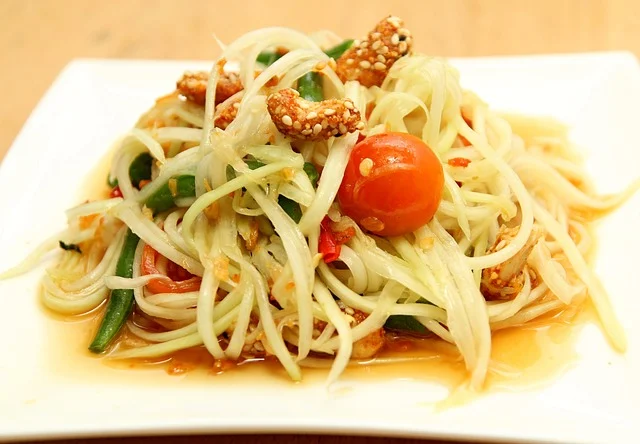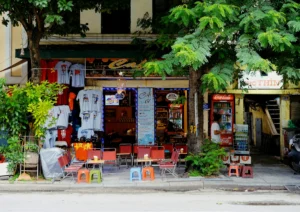The Essence of Lao Flavors
Lao cuisine is characterized by its simplicity, freshness, and bold flavors. The use of fresh herbs, spices, and local ingredients creates a unique gastronomic experience that is both exotic and comforting. Sticky rice, known as khao niao, is a staple food and a symbol of Lao culinary tradition. It is often accompanied by an array of flavorful dishes, ranging from spicy salads to savory stews.
Cultural Influences on Lao Cuisine
The culinary traditions of Laos have been shaped by its history and geography. Influences from neighboring countries, including Thailand, Vietnam, and China, are evident in Lao cooking. However, Lao cuisine maintains its distinct identity through unique techniques and indigenous ingredients.
Signature Dishes of Laos
Larb: The National Dish
Larb (also spelled laap) is often considered the national dish of Laos. This minced meat salad is typically made with chicken, beef, pork, or fish, mixed with lime juice, fish sauce, and a blend of fresh herbs like mint and cilantro. Toasted rice powder adds a delightful crunch, while chili peppers provide a spicy kick. Larb is traditionally served with sticky rice and fresh vegetables, making it a harmonious balance of textures and flavors.
Tam Mak Hoong: Green Papaya Salad
Tam Mak Hoong, or green papaya salad, is a vibrant and refreshing dish that showcases the bold flavors of Lao cuisine. Shredded green papaya is mixed with tomatoes, garlic, chilies, and lime juice, then pounded together in a mortar and pestle. The result is a spicy, tangy, and slightly sweet salad that is often enjoyed as a side dish or a light meal.
Or Lam: A Hearty Stew
Or Lam is a traditional Lao stew that epitomizes comfort food. This hearty dish is made with meat, typically buffalo or beef, and an assortment of vegetables like eggplant and bamboo shoots. The broth is seasoned with lemongrass, galangal, and chili, creating a rich and aromatic flavor profile. The addition of sa kan, a wild pepperwood, gives Or Lam its distinctive taste.

Street Food Delights
Khao Jee: Lao Baguette Sandwich
Khao Jee is a Lao twist on the French baguette, reflecting the country’s colonial past. These sandwiches are filled with a variety of ingredients, such as grilled pork, pâté, pickled vegetables, and fresh herbs. Khao Jee is a popular street food, offering a quick and satisfying meal for locals and visitors alike.
Sai Oua: Lao Sausage
Sai Oua, or Lao sausage, is a flavorful grilled sausage made with minced pork, herbs, and spices. The inclusion of ingredients like lemongrass, kaffir lime leaves, and galangal gives the sausage its aromatic and zesty flavor. Sai Oua is often enjoyed with sticky rice and dipping sauces, making it a favorite snack or appetizer.
Unique Ingredients and Cooking Techniques
Sticky Rice: The Heart of Lao Cuisine
Sticky rice, or khao niao, is the cornerstone of Lao meals. It is traditionally steamed in bamboo baskets and served in small woven containers called tip khao. Sticky rice is used to scoop up food, acting as both a utensil and a complement to various dishes. Its chewy texture and subtle sweetness make it an essential component of Lao dining.
Jeow: Spicy Dipping Sauces
Jeow refers to a variety of spicy dipping sauces that accompany many Lao dishes. Made with ingredients like chili peppers, garlic, shallots, and fermented fish sauce (pa daek), jeow adds a fiery kick to meals. Each region of Laos has its own variations of jeow, showcasing the diversity of flavors across the country.
Dining Etiquette and Traditions
Communal Dining
In Laos, meals are often enjoyed communally, with family and friends sharing dishes from a central table. This tradition fosters a sense of togetherness and hospitality. It is customary to use your right hand when eating with sticky rice, and to always offer food to others before serving yourself.
Festival Foods
Lao cuisine plays a significant role in cultural and religious festivals. During Boun Pi Mai (Lao New Year), special dishes like khao tom (sweet sticky rice cakes) and mok pa (steamed fish in banana leaves) are prepared. These festive foods not only celebrate the occasion but also preserve culinary traditions and heritage.
Exploring Lao Cuisine: Culinary Tours and Cooking Classes
Culinary Tours
Culinary tours offer a unique opportunity to explore the flavors of Laos firsthand. These tours typically include visits to local markets, where participants can discover a variety of fresh produce and traditional ingredients. Guided by knowledgeable chefs or local cooks, tourists can learn about the history and cultural significance of Lao dishes while sampling the delicious offerings.
Cooking Classes
Taking a cooking class in Laos is an immersive way to experience the country’s cuisine. Many classes are held in traditional homes or scenic outdoor settings, providing an authentic cooking environment. Participants can learn how to prepare classic dishes like larb, tam mak hoong, and sticky rice, gaining insight into the techniques and traditions of Lao cooking.



